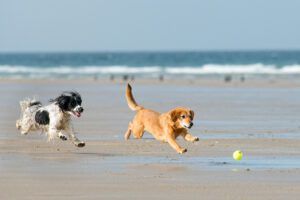Signs of a Torn ACL in Dogs
ACL (anterior cruciate ligament) injury is the most common cause of hindlimb lameness in a dog. The injury may involve partial tearing of the ligament or complete rupture. The ACL is a ligament in the dog’s knee (also called his stifle) that stabilizes the knee during movement.
A dog with an ACL injury may present as chronic, intermittent lameness or as an acute, severe lameness. Note: Technically, in dogs, the appropriate term for this ligament is CCL (cranial cruciate ligament), but because humans are so used to the term “ACL” veterinarians often use CCL and ACL interchangeably.
Signs of an Acute Torn ACL
The most common cause for acute ACL rupture in an otherwise sound dog is trauma. This usually happens in young, athletic, large-breed dogs during exercise or play.
The signs of an acute ACL rupture are quite classic. Usually, the dog is running and playing and suddenly gives a yelp and becomes completely non-weight bearing on a hind leg. The dog often continues to move around but will hike up or hang the affected limb and run on three legs.
After 24 hours or so, most of these dogs start touching their toes to the ground when walking, Many dogs will bear at least some weight intermittently after 48 to 72 hours or so. With an acute ACL injury, there will be no doubt that the dog has suffered a serious, sudden injury.
Chronic Torn ACL
The chronic form of a torn ACL is usually due to the degeneration of the ligament over time. This may have a conformational and/or genetic component but is always exacerbated by obesity. A chronically degenerate ligament with partial tearing may suddenly rupture at any time, presenting as acute on chronic disease.
Signs of chronic ACL injury include intermittent hindlimb lameness that may temporarily resolve with rest and anti-inflammatory medication. It is most common in overweight dogs, as the excess weight puts added stress on the ligaments. It frequently affects both hind limbs, so the dog may have alternating hindlimb lameness or be simultaneously lame on both.
These dogs may have thigh muscle atrophy, decreased range of motion in their knees, pain on full extension of the knee, difficulty rising, and “sloppy sits,” as it is usually not possible for them to comfortably sit squarely on both hind limbs.
Diagnosis and Treatment
If you think your dog may be suffering from an ACL injury, whether acute or chronic, see your veterinarian as soon as possible for diagnosis confirmation and treatment options. ACL injuries frequently lead to arthritis, which is a chronic, painful, debilitating disease with no cure. The sooner medical attention is sought for ACL injury in dogs, the better the outcome.





